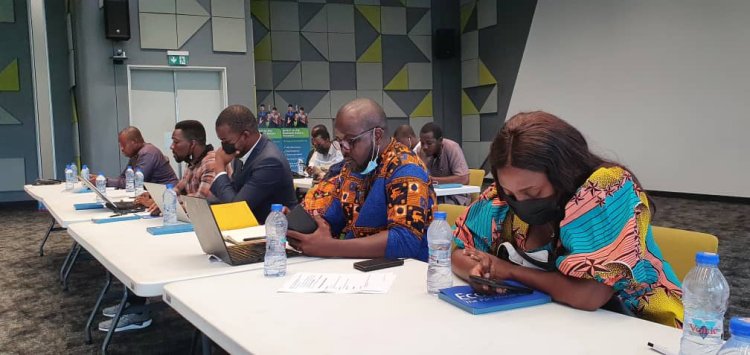Data released by the Bank of Ghana (BoG) indicates that the non-oil real Gross Domestic Product (GDP) has expanded from 1.0 percent in 2020 to 6.9 percent in 2021.
According to the Central Bank, this is the highest non-oil real GDP growth rate since the rebasing was done in 2013 exceeding the target of 5.9 percent for the period.
The bank noted that the nominal GDP for 2021 is estimated at GH¢459,130.9 million, over GH¢18 billion more than the projected outturn of GH¢440,869.4 million for the period, up from GH¢391,940.7 million recorded in 2020.
The First Deputy Governor at the Bank of Ghana (BoG) Dr. Maxwell Opoku-Afari disclosed this in a statement which was read on his behalf by Dr. Phillip Abradu-Otoo, Director of Research at the BoG during a training program held for members of the Journalists For Business Advocacy (JBA) on Thursday, April 28.
The workshop was sponsored by Ecobank Ghana.
Speaking to the journalists, Mr... Opoku-Afari mentioned that the non-oil nominal GDP for 2021 is GH¢437,975.2, up from GH¢378,147.9 million in 2020.
According to him, the major implication of this higher-than-projected GDP outturn for 2021 is that all economic indicators expressed as a ratio of GDP will change to reflect the updated GDP data. These ratios include the debt to GDP ratio, a key factor in determining debt sustainability, the fiscal deficit to GDP ratio, and the Revenue to GDP ratio.
He pointed out that the new GDP data also has implications for the nominal 2022 GDP target and the growth rate as it is based on the 2021 GDP data which have now been updated.
He asserted that the fiscal deficit (including energy and Finsec payments) is now showing a decline (as a percent of GDP) from 15.0 percent to 14.7 percent of GDP for 2020. Similarly, the fiscal deficit of 2021 has reduced from 11.7 percent to 11.4 percent.
He noted that Ghana’s public debt stock expressed as a percentage of GDP now stands at 76.6 percent of GDP at the end of 2021 compared to the earlier reported 80.1 percent. Similarly, the 2020 debt stock has also reduced from 76.1 percent to 74.4 percent, a further confirmation that the rate of debt accumulation has slowed to pre-pandemic levels.
“As such, the Ministry of Finance will update its debt sustainability analysis (DSA) and revise its GDP projections for 2022 and the medium-term to reflect the positive developments in 2021 as well as recent policy decisions which have a bearing on sustaining the momentum towards robust economic growth,” a statement issued by the Finance Ministry said.
“These developments are positive and confirm the fact that the economy is rebounding post-COVID-19, the rate of debt accumulation is tapering off, and there is a slowdown in fiscal expansion with Ghana on track to return to the Fiscal Responsibility Act deficit threshold of 5 percent of GDP by 2024,” the statement added.
He indicated that Ghana’s economy has rebounded strongly from the pandemic, as evidenced by the national accounts data recently released by the Ghana Statistical Service (GSS).
He explained that the overall real Gross Domestic Product (GDP) growth was 5.4 percent in 2021, higher than the targeted 4.4 percent. Non-oil GDP growth was 6.3 percent.
These developments, he said, point to a robust economy that is pushing toward its pre-pandemic level, though downside risks remain, including the potential outbreak of new variants of the Covid-19 pandemic and further headwinds from the Russia-Ukraine war.
“Headline inflation has shifted above the upper band of the medium-term target, driven mainly by food prices, upward adjustments in ex-pump petroleum prices, transport costs, and passthrough of exchange rate depreciation.
“The latest data shows that headline inflation rose sharply to 19.4 percent in March 2022 from 15.7 percent in February on the back of a significant increase in food inflation.
In addition to these trends, there are significant upside risks to the inflation outlook, including increased commodity prices, particularly crude oil, and intensified supply disruptions.
The Bank’s forecast indicates that inflation would trend back towards the medium-term horizon over the next four quarters.
“The remarkable resilience exhibited by the banking sector over the two years could be attributed to the comprehensive financial sector reforms that took place before the Covid-19 pandemic struck in 2020.
The sector continues to remain liquid, profitable, and well-capitalized. The industry’s measure of solvency, the Capital Adequacy Ratio, has remained well above the revised regulatory 13 percent prudential limit. Asset quality, however, declined marginally,” he said.
The latest official GDP data released by the GSS for 2020 and 2021 showed that the economy expanded more than was anticipated and exceeded the Sub-Saharan Africa (SSA) average growth of 4.5 percent for 2021, while the rate of debt accumulation has slowed to pre-pandemic levels. The fiscal expansion has also slowed.
On 20th April 2022, the official provisional 2021 fourth quarter and overall 2021 annual GDP data were released by the GSS.
According to the GSS, real GDP expanded by 7 percent in the fourth quarter of 2021 compared to the 4.3 percent growth recorded in the corresponding period of 2020. Similarly, non-oil real GDP in the fourth quarter of 2021 expanded by 7.6 percent compared to 5.7 percent for the same period in 2020.
On an annual basis, the provisional real GDP growth for 2021 showed a positive outturn of 5.4 percent, exceeding the 4.4 percent 2021 projected outturn by 1 percentage point and the SSA average growth by 0.9 percentage point.
This is a clear confirmation that the economy is on the rebound post the COVID-19 pandemic that saw a revised growth rate of only 0.5 percent in 2020, the Ministry of Finance said in reaction to this development.










